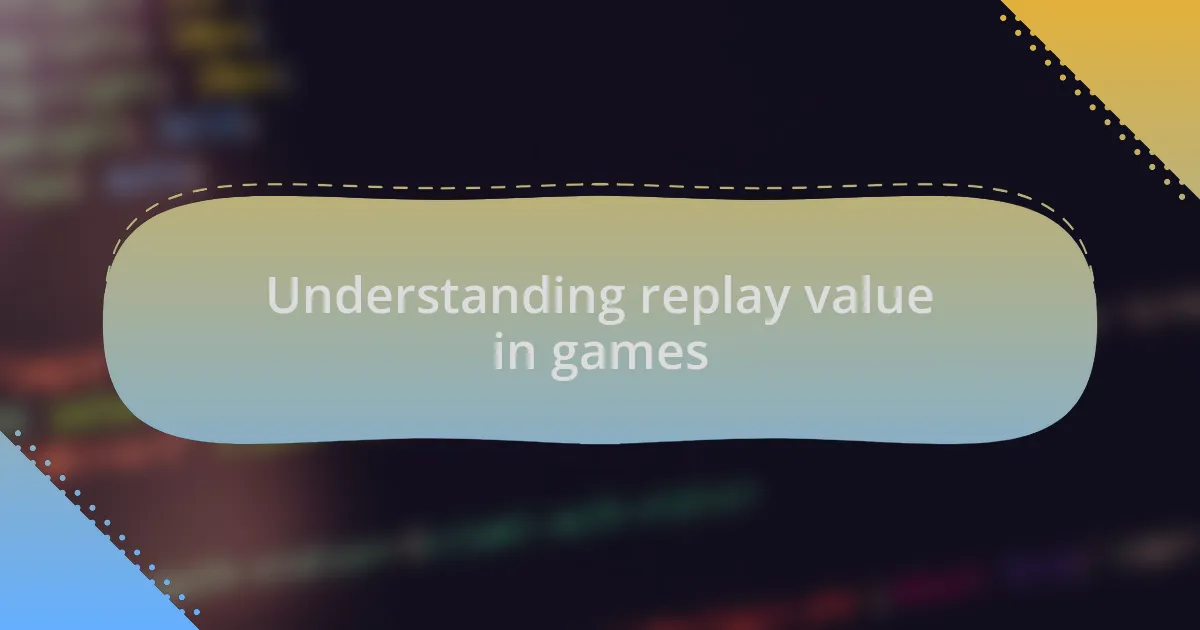Key takeaways:
- Replay value in games is enhanced through branching narratives, new challenges, and player choices, fostering excitement for multiple playthroughs.
- Randomization and procedural generation can create unique player experiences, making each gameplay session distinct and engaging.
- Dynamic difficulty adjustments personalize gameplay by adapting to individual player skills, ensuring balanced challenges and maintaining engagement.
- Engaging side quests enrich the main story by providing meaningful narratives, rewarding outcomes, and opportunities for player choice and customization.

Understanding replay value in games
Replay value in games refers to the enjoyment and motivation a player feels to return to a game after completing it. It’s fascinating to think about what makes us want to experience a story, mechanics, or challenges once more. Personally, I find it thrilling to dive back into a game like “The Witcher 3”—each playthrough unveils new quests and characters I might have missed. This variety is what keeps my interest alive.
One aspect I often ponder is how choices impact our experiences. When I replay games that feature branching narratives, I feel a rush of excitement thinking about the different outcomes. Have you ever wondered how playing through a decision-heavy game like “Detroit: Become Human” can lead you down entirely different paths? It’s that blend of narrative exploration and the thrill of discovery that enhances replay value.
Moreover, the integration of new challenges or modes can significantly boost replayability. I vividly remember the rush I felt when “Dark Souls” introduced its DLC. It not only increased the game’s difficulty but presented fresh lore and mechanics that were worth exploring again. Engaging with games that continually offer novelty rejuvenates the experience and keeps the gaming community buzzing. Isn’t it satisfying to know there’s always something new to uncover, even after you think you’ve seen it all?

Implementing randomization in game design
Randomization can breathe fresh life into game design by introducing unpredictability in various aspects, from enemy encounters to loot drops. I remember the first time I played “Borderlands” and encountered unique weapons and items on each run. It felt exhilarating to experiment with different builds and strategies, making each session feel distinct and engaging.
Incorporating procedural generation is another effective way to leverage randomization. Games like “Enter the Gungeon” offer a unique layout with each playthrough, forcing me to adapt my strategies and keep every moment exciting. It’s like solving a new puzzle every time I hit the start button—do you feel that same thrill when navigating the unknown?
Moreover, randomness can be applied to narrative elements too, allowing for diverse player experiences. While exploring a game like “The Binding of Isaac,” I found myself reshaping my approach based on randomly generated power-ups. That variability not only keeps me on my toes but often leads to unexpected and unforgettable moments in gameplay, enhancing the overall experience.

Creating dynamic difficulty adjustments
Dynamic difficulty adjustments are a powerful tool in game design, allowing games to tailor their challenge to the player’s skill level. I recall playing “Dark Souls,” where the game subtly adapted enemy aggression based on my performance. There were moments when I felt like I was finally mastering a boss fight, and the game responded by shifting tactics, keeping each encounter tense and exhilarating. Isn’t there something thrilling about feeling like the game is watching you, adjusting just enough to keep you engaged?
Implementing a system that monitors player performance can create a more personalized experience. I’ve seen games track things like the number of times I fail a level and then adjust enemy health or attack patterns accordingly. When I first experienced this in “Celeste,” I noticed that even on rough days, the game was still enjoyable because it provided just the right amount of challenge. How can we expect players to fully enjoy a title if they feel overwhelmed or bored?
Moreover, providing players with options to configure their difficulty can significantly enhance replayability. For instance, in “Resident Evil,” I could tweak the difficulty settings mid-game, allowing me to experiment with varying challenges. This flexibility reminds players that they can shape their experience according to their mood or skill level, inviting them back for more—and isn’t that what every game developer wants?

Designing engaging side quests
When designing engaging side quests, I often think about how they can act as a breath of fresh air within the main story. I remember playing “The Witcher 3,” where a seemingly simple request to find a lost cat spiraled into a narrative filled with unexpected twists. This not only kept me entertained but also deepened my connection to the game’s world and characters. Isn’t it fascinating how a side quest can transform a moment of mundane into a memorable adventure?
Another key aspect is to ensure that side quests feel rewarding and meaningful. In my experience, quests that have tangible impacts on the game world leave a lasting impression. For instance, in “Skyrim,” when I helped a villager reclaim their home from bandits, I noticed the area transformed and saw the NPC thrive afterward. I often ask myself: don’t players crave that sense of accomplishment that resonates beyond the immediate experience?
Lastly, integrating layers of customization and player choice in side quests can greatly enhance engagement. I fondly recall how “Fallout 4” presented multiple paths to fulfill a side quest. Whether I chose stealth, persuasion, or direct combat, each decision shaped the outcome and left me curious to uncover all possible scenarios. Wouldn’t a quest that adapitates to how players decide to approach it encourage them to replay and explore different angles?